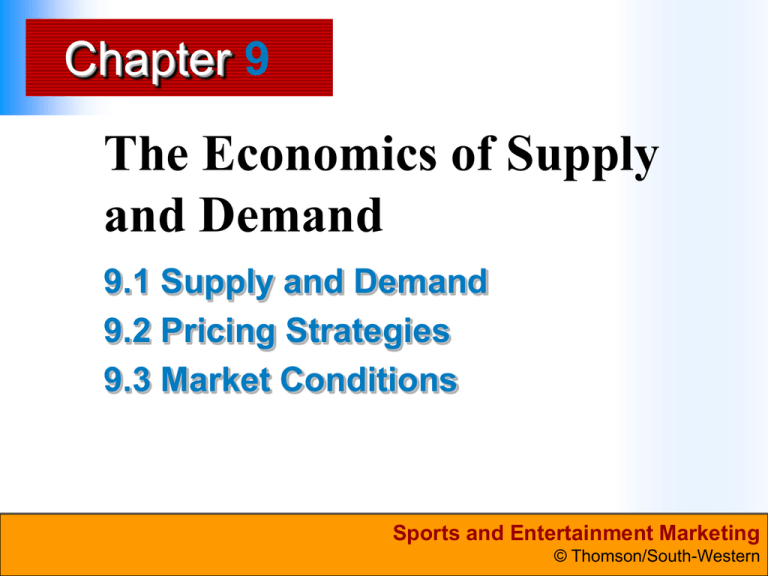Chapter 9 PPT The Economics of Supply and Demand
advertisement

Chapter 9 The Economics of Supply and Demand 9.1 Supply and Demand 9.2 Pricing Strategies 9.3 Market Conditions Sports and Entertainment Marketing © Thomson/South-Western Winning Strategies Cereal Stars Wheaties cereal discovered by accident first featured star was fictitious Lou Gehrig was first actual star featured many athletes make it a career goal to be featured on the box in 1999, women in sports were featured Chapter 9 Slide 2 Sports and Entertainment Marketing © Thomson/South-Western Lesson 9.1 Supply and Demand Goals Explain the relationships between supply, demand, and price. Discuss the government’s influence on pricing. Chapter 9 Slide 3 Sports and Entertainment Marketing © Thomson/South-Western Terms law of demand law of supply scarcity equilibrium price fixing bait and switch price discrimination Chapter 9 Slide 4 Sports and Entertainment Marketing © Thomson/South-Western THE LAWS OF SUPPLY AND DEMAND demand the relationship between the quantity of a product that consumers are willing and able to purchase and the price Chapter 9 Slide 5 Sports and Entertainment Marketing © Thomson/South-Western producers businesses that use resources to develop products and services supply the relationship between the quantity of a product that producers are willing and able to provide and the price Chapter 9 Slide 6 Sports and Entertainment Marketing © Thomson/South-Western Price-Demand Relationships law of demand an inverse relationship when the price goes up, demand goes down when the price goes down, demand goes up Chapter 9 Slide 7 Sports and Entertainment Marketing © Thomson/South-Western Price-Supply Relationships law of supply when the price goes up the supply produced goes up when the price goes down the supply produced goes down Chapter 9 Slide 8 Sports and Entertainment Marketing © Thomson/South-Western Scarcity scarcity consumers have limited money to spend producers have limited resources to use for production Consumers and producers must decide how to use their limited resources to meet unlimited wants and needs. Chapter 9 Slide 9 Sports and Entertainment Marketing © Thomson/South-Western Equilibrium equilibrium the point where the supply and demand curves intersect indicates the best quantity and price for goods and services Chapter 9 Slide 10 Sports and Entertainment Marketing © Thomson/South-Western Chapter 9 Slide 11 Sports and Entertainment Marketing © Thomson/South-Western Concerts in the Spotlight Concert prices can be set high. limited supply high demand If demand is high enough, supply can be increased by adding a second show. Chapter 9 Slide 12 Sports and Entertainment Marketing © Thomson/South-Western How does price affect demand? Chapter 9 Slide 13 Sports and Entertainment Marketing © Thomson/South-Western GOVERNMENT INFLUENCE ON PRICING private-enterprise system based upon independent decisions made by consumers and businesses Chapter 9 Slide 14 Sports and Entertainment Marketing © Thomson/South-Western The U.S. government has an influence on prices charged for merchandise directly and indirectly through antitrust laws, taxation, and various consumer protection laws. Chapter 9 Slide 15 Sports and Entertainment Marketing © Thomson/South-Western Benefits of Competition monopoly where one business controls the entire market Antitrust laws encourage competition and help avoid monopolies. Chapter 9 Slide 16 Sports and Entertainment Marketing © Thomson/South-Western Taxation Taxation can be used by the government to encourage or discourage sales. Chapter 9 Slide 17 Sports and Entertainment Marketing © Thomson/South-Western Illegal Pricing price fixing when related businesses conspire to charge high prices illegal in U.S. Chapter 9 Slide 18 Sports and Entertainment Marketing © Thomson/South-Western bait and switch when a product that is advertised at a great price is “out of stock” salesperson tries to sell customer a higherpriced alternative advertised prices cannot be misleading price discrimination occurs when one individual, group, or business is charged a higher price than others purchasing the same product or service Chapter 9 Slide 19 Sports and Entertainment Marketing © Thomson/South-Western List three ways the government influences pricing. Chapter 9 Slide 20 Sports and Entertainment Marketing © Thomson/South-Western Lesson 9.2 Pricing Strategies Goals Discuss pricing strategies used by businesses to increase sales. List five steps for determining price. Chapter 9 Slide 21 Sports and Entertainment Marketing © Thomson/South-Western Terms operating expenses markup price lines loss-leader pricing Chapter 9 Slide 22 Sports and Entertainment Marketing © Thomson/South-Western PRICING CONSIDERATIONS price the amount that customers pay for products and services Chapter 9 Slide 23 Sports and Entertainment Marketing © Thomson/South-Western pricing the process of establishing and communicating the value of goods and services to customers operating expenses all the costs associated with running your business markup the amount that is added to the cost of an item to cover operating expenses and allow for a profit Chapter 9 Slide 24 Sports and Entertainment Marketing © Thomson/South-Western pure competition many companies offering the same product customers do not recognize major differences in the brands the market will drive the prices low as businesses compete for consumers’ business market price determined by laws of supply and demand if not sufficient to cover costs and allow for a profit, the business will cease production of the product Chapter 9 Slide 25 Sports and Entertainment Marketing © Thomson/South-Western Pricing Policies one-price policy all customers pay the same price for a product flexible pricing policy allows customers to negotiate a price within a range Chapter 9 Slide 26 Sports and Entertainment Marketing © Thomson/South-Western price lines distinct categories of merchandise based upon price, quality, and features geographic pricing allows pricing variations based upon geographic location Chapter 9 Slide 27 Sports and Entertainment Marketing © Thomson/South-Western A Variety of Pricing Strategies Psychological Pricing creating an illusion for customers Prestige Pricing higher-than-average pricing targets customers seeking status and quality Chapter 9 Slide 28 Sports and Entertainment Marketing © Thomson/South-Western Volume Pricing when a supplier provides a lower price to a customer who buys a high volume of product Promotional Pricing offering customers an incentive to get them in the store two-hour/ 50% off sale Chapter 9 Slide 29 Sports and Entertainment Marketing © Thomson/South-Western Loss-Leader Pricing the willingness to take a loss on the reduced prices of selected items in order to create more customer traffic special event promotion associates a special sale with a major event Chapter 9 Slide 30 Sports and Entertainment Marketing © Thomson/South-Western rebates coupons on products that customers can mail in for a refund depends upon further action by the customer multiple-unit pricing a volume based discount trade-in allowance giving a store your old product when purchasing a new product usually results in a discount on the new product purchase Chapter 9 Slide 31 Sports and Entertainment Marketing © Thomson/South-Western List and describe five pricing strategies to increase sales. Chapter 9 Slide 32 Sports and Entertainment Marketing © Thomson/South-Western DETERMINING THE PRICE There are five steps to determining the price to charge for a product or service. Chapter 9 Slide 33 Sports and Entertainment Marketing © Thomson/South-Western 1. Establish the price objectives. 2. Determine the cost of the product or service. 3. Estimate consumer demand for your product or service. 4. Study the competition. 5. Decide on a pricing strategy. Chapter 9 Slide 34 Sports and Entertainment Marketing © Thomson/South-Western List the five steps for determining price. Chapter 9 Slide 35 Sports and Entertainment Marketing © Thomson/South-Western Lesson 9.3 Market Conditions Goals Define the business cycle and describe its impact on sports and entertainment. Discuss the importance of monitoring consumer trends. Chapter 9 Slide 36 Sports and Entertainment Marketing © Thomson/South-Western Terms business cycle inflation shoulder periods Chapter 9 Slide 37 Sports and Entertainment Marketing © Thomson/South-Western IMPACT OF THE BUSINESS CYCLE business cycle (economic cycle) the ups and downs of the economy - Chapter 9 Slide 38 Sports and Entertainment Marketing © Thomson/South-Western Chapter 9 Slide 39 Sports and Entertainment Marketing © Thomson/South-Western Expansion expansion the upside of a business cycle peak highest point of growth in the economy Chapter 9 Slide 40 Sports and Entertainment Marketing © Thomson/South-Western Contraction contraction the downside of a business cycle recession or depression inflation when prices for goods and services rise faster than consumer income Chapter 9 Slide 41 Sports and Entertainment Marketing © Thomson/South-Western Business Reaction trough lowest point of contraction recovery economy shows signs of improving prosperity the period of business expansion following recovery Chapter 9 Slide 42 Sports and Entertainment Marketing © Thomson/South-Western Seasonal Cycles For some businesses, demand fluctuates with the seasons. high season the season with the highest demand low season the season with the lowest demand Chapter 9 Slide 43 Sports and Entertainment Marketing © Thomson/South-Western shoulder periods periods of moderate demand Sports and entertainment marketing strategies must be developed to help even out the fluctuations created by changing seasonal demands. Chapter 9 Slide 44 Sports and Entertainment Marketing © Thomson/South-Western What is inflation and how does it contribute to recession? Chapter 9 Slide 45 Sports and Entertainment Marketing © Thomson/South-Western IMPACT OF CONSUMER TRENDS Trends are dictated by television revenue sponsors consumer demand - Chapter 9 Slide 46 Sports and Entertainment Marketing © Thomson/South-Western Retro Television Retro show fans like to relive the good old days and recall positive memories of growing up watching the stars in the sitcoms. Popular show reruns are inexpensive to show on television. Chapter 9 Slide 47 Sports and Entertainment Marketing © Thomson/South-Western Game Shows There are game show channels that rerun old favorites. New game shows are being produced to meet demand. Chapter 9 Slide 48 Sports and Entertainment Marketing © Thomson/South-Western Audience Ratings Speak Television networks cannot afford the risk of having viewers switch channels to watch a more exciting show on a competing network. Some series do not last more than six airings due to flat ratings. Chapter 9 Slide 49 Sports and Entertainment Marketing © Thomson/South-Western Socio-Culture Issues Socio-culture issues include trends in customer attitudes lifestyles opinions demographics Assessing consumers’ ever-changing needs and wants is the bottom line for the success or failure of a product or service. Chapter 9 Slide 50 Sports and Entertainment Marketing © Thomson/South-Western Why must sports and entertainment marketers pay careful attention to consumer trends? Chapter 9 Slide 51 Sports and Entertainment Marketing © Thomson/South-Western PERFORMANCE INDICATORS EVALUATED Demonstrate an understanding of the economic challenges facing television network programming. Demonstrate critical thinking and problemsolving skills. Chapter 9 Slide 52 Sports and Entertainment Marketing © Thomson/South-Western Describe promotions appropriate for the target market that will result in increased ratings for the bowl game. Describe advertisements that will attract the attention of your target market. Develop a strategy to encourage viewers of the Price Is Right to watch the bowl game. Chapter 9 Slide 53 Sports and Entertainment Marketing © Thomson/South-Western THINK CRITICALLY 1. How have the number of bowl games affected the television ratings for the games? 2. Why are the scheduled date and time of the game important factors for ratings and promotions? Chapter 9 Slide 54 Sports and Entertainment Marketing © Thomson/South-Western 3. Why should television networks pay attention to the programming scheduled around the game and on competing networks when making decisions? 4. How can an association be made between the game show and the bowl game? Chapter 9 Slide 55 Sports and Entertainment Marketing © Thomson/South-Western








